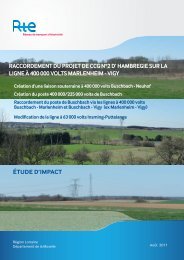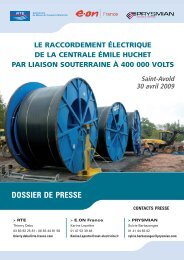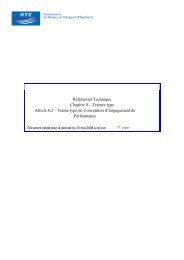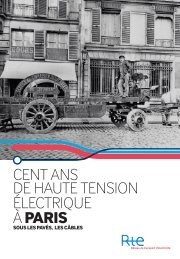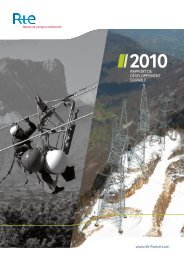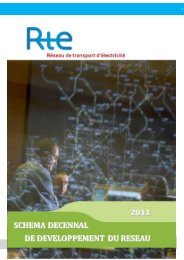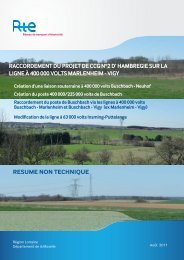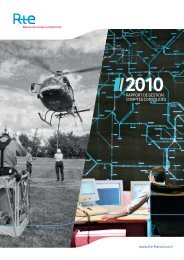Power System Reliability Report - RTE
Power System Reliability Report - RTE
Power System Reliability Report - RTE
- No tags were found...
You also want an ePaper? Increase the reach of your titles
YUMPU automatically turns print PDFs into web optimized ePapers that Google loves.
R-AUDIT-SG-DAR-MAS-11-2011/022010 <strong>Reliability</strong> <strong>Report</strong>Page : 15/408 juillet 2011impact of flows in neighbouring networks on the <strong>RTE</strong> network. The rapid variability of flows in a singleday is illustrated on the diagram opposite for an interconnection line between Germany and France;this variability naturally affects the domestic grid.The examination of the reports analysing these events and of the regional reliability reports showsthat a sensitive point for the preparation of day ahead and intraday operation concerns the analysis ofthe sensitivity of the studies to variations in hypotheses, in particular for expected consumption orexchange levels near the borders. This sensitivity increases with the development of the intradayactivity of market companies, of intermittent energies and thermosensitivity. The “setting” of thecoverage level required to deal with the uncertainties in hypotheses is a topic that required moredetailed work in late 2010.2.6 Contingencies affecting the transmission facilitiesThe number of short-circuits (7723) affecting transmission facilities is down by 18.6% compared with2009, continuing a downward trend observed for several years now. The drop essentially concernsHV1 networks but also 400 kV lines (1.7 short circuits for 100 km versus 2.1 in 2009) and 225 kV lines(5.7 for 100 km versus 6.5), with a ratio roughly 6 times lower between 400 kV and HV1 links, whichcan be attributed to more protective construction measures.97% of these short-circuits are transient and therefore do not affect the availability of facilities whenthe re-energizing equipment is functioning correctly 8 .61.9 % of these short-circuits are of proven atmosphericorigin (68.9% in 2009). The number of lightning strikes inFrance decreased in 2010, but the number of short-circuitsdue to lightning dropped even more, confirming the trend ofprevious years.The proven or presumed main causes of the remaining38.1% are: bird activity (15.3%), construction characteristics(15.2%) resulting from optimisation choices that evolveddepending on the construction period (recent structures takefeedback into account), pollution (3.8 %), equipment breakdowns (1.7 %) and various other causes(external aggressions, human errors, etc.) for 2.1 %.In terms of reliability, it is important to focus the analysis faults involving double 400kV lines and400kV busbars. During busbar faults, all equipment connected to the bar or the section of bar isautomatically disconnected. Both types of incidents, but particularly the second, can cause large-scaleincidents. In 2010 the following were logged:- 12 simultaneous faults on a double 400kV line (11 in 2009), all transient (3 definitive in2009)- Three 400 kV busbar faults (versus 8 in 2009), two of which were due to the destruction ofequipment and one to human error.One of these busbar faults gave rise to an ESS level B. A 225 kV busbar fault also gave rise to an ESSlevel B.The absence of short-circuits on the 400kV network following contact with vegetation shows that thepruning work carried out by <strong>RTE</strong> is effective for this voltage level. However, there was an incident ofthis type on a 225 kV line (ESS A, cf §2.5).3 Evolution of the reliability reference guideDétail des causes atmosphériquesThis chapter describes the evolutions in reliability reference guides, be they established outside of <strong>RTE</strong>or internally. It concerns all types of requirements and orders from all sources, contracts establishedby <strong>RTE</strong> with any type of party that may have an impact on reliability and also reference documents(studies, position papers, etc.) that concern this field.8 From a reliability standpoint, these transient short-circuits are without risk if they are cleared sufficently rapidlyso as to not affect the dynamic stability of the units, which has been confirmed – see §4.1.2Copyright <strong>RTE</strong>. This document is the property of <strong>RTE</strong>. Any communication, reproduction, publication even partial is forbidden without the express written authorisationElectricity Transmission <strong>System</strong> operator (<strong>RTE</strong>)




